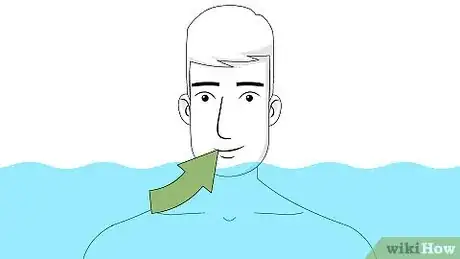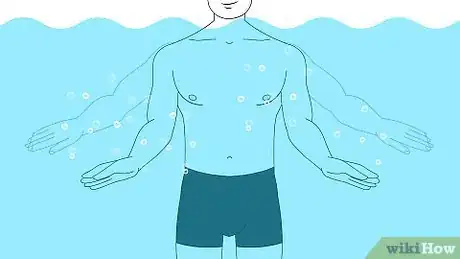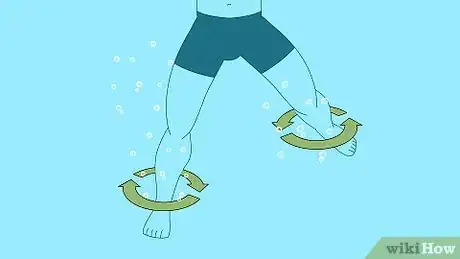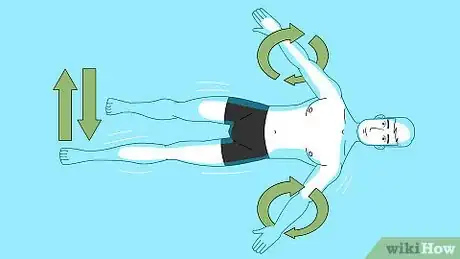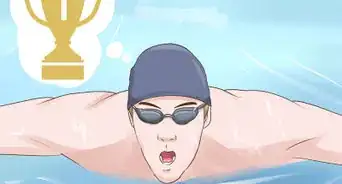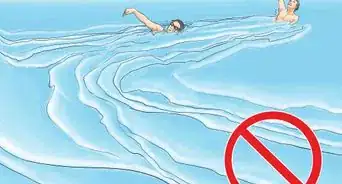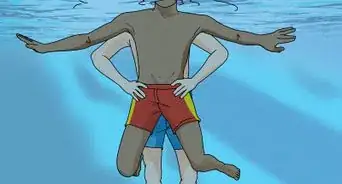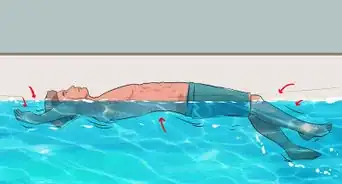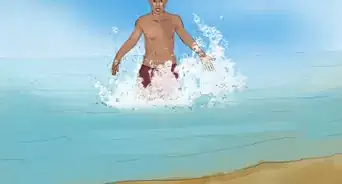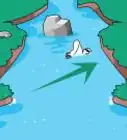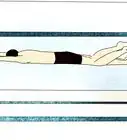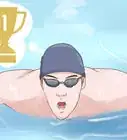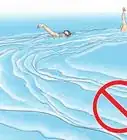This article was co-authored by Brad Hurvitz and by wikiHow staff writer, Ali Garbacz. Brad Hurvitz is a Certified Swimming Instructor for My Baby Swims, an adolescent swimming school based in La Jolla, California. Brad is trained as an Infant Swimming Resource (ISR) instructor with ISR's Self-Rescue® program. He specializes in training children aged six months to six years of age survival skills like floating on their back to breathe and swimming back to the wall, while also educating parents on how to better keep their kids safe. He has a Master of Business Administration from Oregon State University.
wikiHow marks an article as reader-approved once it receives enough positive feedback. This article received 24 testimonials and 100% of readers who voted found it helpful, earning it our reader-approved status.
This article has been viewed 1,133,423 times.
Treading water is one of the first steps you can take towards learning how to swim, and it’s also a very important skill to learn when it comes down to survival situations. This article will break down the various techniques and help you master the movements needed to tread water. As you read, practice each movement so you can feel more confident and safe the next time you step into the water.
Things You Should Know
- Stay upright in the water and spread your arms out, moving them back and forth as you move your legs in a motion similar to pedaling a bike.
- Conserve energy by laying on your back and paddling your arms and legs.
- Tread water just with your feet by kicking your feet with toes pointed in a flutter kick, or by bending your legs at the knee and kicking them out in a frog kick.
- Keep yourself afloat using the sculling technique by spreading your arms out to the side, bringing your hands together in front of your chest, then pushing back outwards.
Steps
Basic Movements
-
1Move both your arms and legs to keep your head above the water. Make use of all four of your limbs and keep your body upright (vertical). Turning your body horizontally and kicking with your legs will mean that you’re swimming, not treading water.[1]
-
2Spread your arms out to the side and move them back and forth. Move your arms forward and back with your palms facing the direction your arms are moving. This will keep your upper body up. Moving your arms in a vertical motion will cause your body to bob up and down in the water.[2]Advertisement
-
3Pedal your legs in a circular motion or kick your feet back and forth. If you are moving your legs in a circular fashion, keep them flexed as your move them in a way similar to how you would pedal a bike. If you are kicking back and forth, point your feet downward and kick them constantly.[3]
-
4Keep your chin lifted and breathe normally. Keep your head above water and try to slowly regulate your breathing. Lift your chin and slightly tilt back your head. Slowing down your breath will help you calm down, conserve energy, and tread water for longer.[4]
-
5Lean back and gently paddle your arms and feet to conserve energy. Give your body a temporary break from paddling by angling your body so you’re slightly leaning back in the water. You'll still have to paddle with both arms and legs, but not nearly as much as you would have to with your body vertical.[5]
-
6Hold onto a flotation device if you're having trouble staying above water. If there is anything near you that you can hold onto to stay afloat, do so in order to save energy. A raft, log, paddle, or anything equally as buoyant will do the trick.[6]
Treading Techniques
-
1Start easy by doing the dog paddle. Extend one arm and draw it back in towards your body, and then keep alternating between your left and right arms in a clawing motion. Point your toes and keep kicking your feet the entire time.[7]
- Advantage: This basic technique doesn’t require a lot of practice
- Disadvantage: It saps energy fast, so you won't be able to do this technique for very long.
-
2Use your feet as propellers by doing the flutter kick. Keep your arms outstretched for balance and kick your feet rapidly. Point your toes downward and kick one leg forward as you kick the other leg back. Maintain a consistent back and forth motion.
- Advantage: Your arms remain free while doing the flutter kick, giving you an opportunity to rest them.
- Disadvantage: Because you're using just your legs to stay above water, it can be taxing for your lower body.
-
3Save energy by doing the frog kick. Starting with your legs together, bend your legs at the knees then quickly extend them and whip them to the side. Draw your legs back together and repeat the motion. Point your toes as you kick out your legs and flex them when you bring your legs back together.[8]
- Advantage: This kick is less tiring than the flutter kick and the dog paddle.
- Disadvantage: The technique causes you to bob up and down in the water instead of staying relatively motionless.
-
4Tread water with just your hands by sculling. To scull, keep your hands outstretched to the side and completely submerged. With your palms facing inward, keep your arms straight and move your hands towards one another until they are almost touching. When you've reached this point, turn your palms outward and move your hands back out to their original position. Keep your arms moving in one fluid motion without stopping between moving your arms forward then back.[9]
- Advantage: Your legs remain free when sculling, allowing you to combine this with another foot treading technique such as the flutter kick.
- Disadvantage: Minus your head, your entire body will be submerged in the water.
-
5Tread for a longer period of time with the eggbeater. Also called the “rotary kick,” do this by circling one leg clockwise and the other counterclockwise. You should be kicking one leg out as you bring the other in.[10]
- Advantage: You save a lot of energy doing this technique if done correctly.
- Disadvantage: This is a hard technique to perfect, and many people need to practice extensively in order to learn it.
-
6Tread water horizontally with the little helicopter. Lay back in the water as you would when you float on your back. Immediately move your hands in a backwards circular motion and kick your feet up and down with pointed toes.
- Advantage: It’s very simple to explain to children.
- Disadvantage: Moving your hands in this circular motion can become tiring.
Community Q&A
-
QuestionDo you have to dog paddle or kick your feet while sculling?
 wikiHow Staff EditorThis answer was written by one of our trained team of researchers who validated it for accuracy and comprehensiveness.
wikiHow Staff EditorThis answer was written by one of our trained team of researchers who validated it for accuracy and comprehensiveness.
Staff Answer wikiHow Staff EditorStaff AnswerSculling is technically one way to keep yourself afloat using just your arms, moving your feet in some way will help you conserve energy and help propel more of your body up above the water.
wikiHow Staff EditorStaff AnswerSculling is technically one way to keep yourself afloat using just your arms, moving your feet in some way will help you conserve energy and help propel more of your body up above the water. -
QuestionCan you tread water by moving you legs like riding a bicycle ?
 wikiHow Staff EditorThis answer was written by one of our trained team of researchers who validated it for accuracy and comprehensiveness.
wikiHow Staff EditorThis answer was written by one of our trained team of researchers who validated it for accuracy and comprehensiveness.
Staff Answer wikiHow Staff EditorStaff AnswerYes. When treading water, you can either kick your feet back and forth while keeping your toes pointed, or you can move your feet in a circular motion (like pedaling a bike) while keeping them flexed. In both cases, your arms should be extended outwards at your sides and sweeping back and forth through the water.
wikiHow Staff EditorStaff AnswerYes. When treading water, you can either kick your feet back and forth while keeping your toes pointed, or you can move your feet in a circular motion (like pedaling a bike) while keeping them flexed. In both cases, your arms should be extended outwards at your sides and sweeping back and forth through the water. -
QuestionIf you can't tread water, are you doing something wrong?
 wikiHow Staff EditorThis answer was written by one of our trained team of researchers who validated it for accuracy and comprehensiveness.
wikiHow Staff EditorThis answer was written by one of our trained team of researchers who validated it for accuracy and comprehensiveness.
Staff Answer wikiHow Staff EditorStaff AnswerTreading water, just like swimming, takes practice and getting used to. Before you even get in the water, practice some of the movements needed to tread water while you're on solid ground. Practice kicking out your feet one at a time and moving your arms in a back and forth motion while extending them out at your sides.
wikiHow Staff EditorStaff AnswerTreading water, just like swimming, takes practice and getting used to. Before you even get in the water, practice some of the movements needed to tread water while you're on solid ground. Practice kicking out your feet one at a time and moving your arms in a back and forth motion while extending them out at your sides.
Warnings
- If you're new at swimming, don't try to impress somebody in the water (like treading water without arms, without legs, etc.).⧼thumbs_response⧽
- Always swim with a buddy so you can watch out for each other.⧼thumbs_response⧽
References
- ↑ http://www.your-personal-swim-coach.nl/swimming-tip-how-to-tread-water-to-stay-afloat/
- ↑ http://www.your-personal-swim-coach.nl/swimming-tip-how-to-tread-water-to-stay-afloat/
- ↑ http://www.your-personal-swim-coach.nl/swimming-tip-how-to-tread-water-to-stay-afloat/
- ↑ http://www.your-personal-swim-coach.nl/swimming-tip-how-to-tread-water-to-stay-afloat/
- ↑ http://www.your-personal-swim-coach.nl/swimming-tip-how-to-tread-water-to-stay-afloat/
- ↑ http://www.your-personal-swim-coach.nl/swimming-tip-how-to-tread-water-to-stay-afloat/
- ↑ https://www.enjoy-swimming.com/dog-paddle.html
- ↑ https://aquaticglee.com/water-treading/
- ↑ https://www.enjoy-swimming.com/sculling-water.html
- ↑ https://aquaticglee.com/water-treading/
- Videos provided by SwimTechnique TV
About This Article
To tread water, keep your body vertical in the water and your head up above the surface. Then, move your arms back and forth horizontally to keep your upper body afloat. At the same time, move your legs around in a circular motion, keeping your feet stiff. If you get tired, give yourself a break by lying on your back so that you don’t have to paddle with your arms and legs as much. For different kicking techniques to use while treading water, read on!

